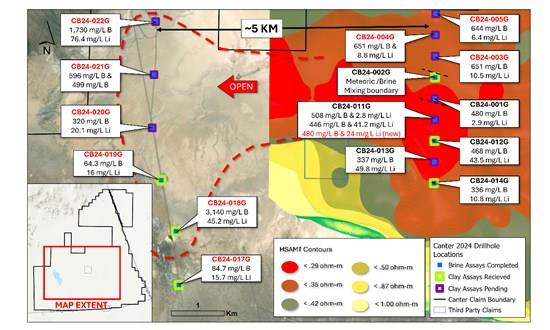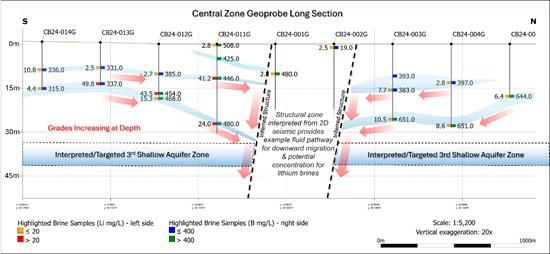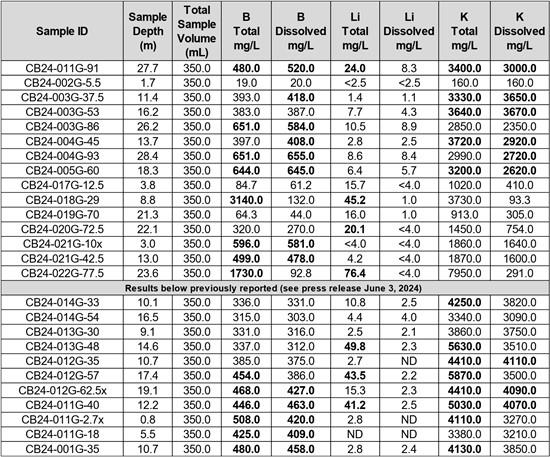(MENAFN- Newsfile Corp)
Vancouver, British Columbia--(Newsfile Corp. - July 2, 2024) - Canter Resources Corp. (CSE: CRC) (OTC Pink: CNRCF) (FSE: 6O1) (" Canter " or the " Company ") is pleased to report additional brine assay results from the Company's completed 15-hole Phase I shallow Geoprobe drill program at its Columbus Lithium-Boron Project (" Columbus " or the " Project "), located near Tonopah, Nevada. The Company has now received all brine assays corresponding to its Phase I program with clay assay results pending for nine (9) holes.
Brine Assay Highlights & Takeaways:
Highest Grades to Date: The latest brine assay results include the highest boron ("B") and lithium ("Li") values from Phase I, with total concentrations up to 3,140 mg/L B and 76.4 mg/L Li (see Summary of Results section for analysis and interpretations).
Consistent Brine Aquifers: Two shallow aquifer horizons (<100 feet ("ft") / 30.5 metres ("m")) were intersected at similar depths in most of the drill holes (see Figures 1-2).
Boron Grades Increasing with Depth: The six (6) new assay results at depths > 55 ft (16.8 m) in the central grid of drill holes averaged 558 mg/L B, with two 651 mg/L B samples collected at 86 ft (26.2 m) and 93 ft (28.3 m), respectively (see Figure 2).
Significant Lateral Extent: Higher grade boron and lithium-enriched brines were encountered in drilling located more than five (5) kilometres ("km") west of the central grid, demonstrating the potential for lateral continuity of individual aquifer horizons and widespread mineralization.
Geochemical & Geological Model: Dynamic geochemical system in which boron preferentially precipitates in shallow zones, with the primary target zones for significant lithium concentrations remaining at greater depths in deeper aquifers and structural traps.
"The latest brine results from this shallow interval have provided us with valuable geochemical data for our 3D model and deeper targeting, while consistently intersecting shallow aquifer zones and demonstrating the multi-commodity upside at Columbus," stated Canter CEO, Joness Lang. "The exceptional boron grades near surface show significant mineral resource potential in the upper levels of the system and the increasing downhole lithium concentrations further support our model and deeper drilling plans. We look forward to receiving the clay results and launching a focused 10-hole follow-up Phase II program in the coming weeks."
Summary of Results: Observations and Interpretations
Initial observations suggest a dynamic geochemical system in which boron preferentially precipitates in shallow zones. The preliminary results and discovery of high-grade boron along with elevated barium and potassium in the upper brine generation layer indicate distinct solubility and mobility patterns for lithium and boron and supports the underlying basin deposit model. Boron tends to precipitate and bind in clays at shallow depths, influenced by pH and reducing conditions while lithium is expected to remain more soluble and migrates towards deeper aquifers and structural traps.
The water sampling program from this Phase I campaign suggests significant multi-commodity potential with widespread near-surface lithium and boron mineralization in brines (see Figure 1).

Figure 1 - Plan view showing brine results only with new assays corresponding to red Drill ID labels.
To view an enhanced version of this graphic, please visit:
The additional brine assay results further demonstrate the potential for very significant boron concentrations in the shallow aquifers at Columbus, with new high-grade (>600 mg/L B) results consistently obtained from the northern half of the central drilling grid and peak total values of 1,730 mg/L and 3,140 mg/L B more than five (5) kms to the west. New lithium results from the western grid ranged from 4.2 to 76.4 mg/L Li and, while more modest grade (6 to 24 mg/L Li), the new brine results from the central grid showed increasing lithium concentration trends at depth (total and dissolved), which further supports the Company's deposit model at Columbus and higher-grade lithium targets at more moderate depths.
Central Drilling Grid
A total of nine (9) holes were completed in the central grid. The new brine results to the north of an interpreted brine mixing boundary are favourable and indicate significant mineralization potential, with high boron grades and anomalous lithium, both increasing at depth (see Figure 2). The findings within this grid are consistent within the 0.5 ohm-metre and 0.3 ohm-metre areas of the geophysical anomaly, with an interpreted third aquifer zone just below the limits of drilling from Phase I at 100-150 ft (approximately 30-45 m). The total lithium values also show a narrowing range and an increase in dissolved lithium numbers with depth, suggesting lithium is beginning to show signs of further precipitation at deeper levels. Specific drill holes and depths highlight these trends, providing valuable data for ongoing exploration efforts.

Figure 2 - Long section view (looking west) of central drilling grid showing interpreted aquifer zones, inferred structure and brine mixing boundary, increasing Li-B concentration trends and interpretive shallow aquifer zones including a third favourable horizon (based on previous downhole geophysics) that will be tested in Phase II.
To view an enhanced version of this graphic, please visit:
Western Drilling Grid
Drilling in the western grid (six holes), located approximately five (5) km west of the central grid, was designed in part to test the inferred open-ended projection of the HSAMT anomaly (see press release April 8, 2024). Significant mineralization was observed, with peak boron values reaching up to 3,140 mg/L B (CB24-018G) and 1,730 mg/L B (CB24-022G). CB24-021G also returned consistent boron at multiple depths (499 mg/L and 596 mg/L B) located directly due west from the HSAMT projection (see Figure 1). Total lithium concentrations ranged from 4.2 to 76.4 mg/L Li (consistently > 15 mg/L), underpinning the potential for widespread mineralization laterally.

Table 1 - Brine Assay Highlights from Phase I Shallow Drilling at Columbus
To view an enhanced version of this graphic, please visit:
Notes: Differences in detection limits are due to the Dilution Factor (DF) being used. (x) = Duplicate. Total solids encompass all the solid matter, both dissolved and suspended, found in water, including organic and inorganic substances. In contrast, dissolved solids refer specifically to the portion of total solids that are soluble in water, such as salts, minerals, and some organic materials, passing through a filter and remaining in solution. The highly anomalous results from CB24-018G were retested at the request of the Company and they were confirmed and validated by WetLabs internal QA/QC.
Summary
The brine results have been incorporated into the Company's 3D model and are being analyzed to help with the precision for deeper drilling at Columbus.
The Company's general thesis at Columbus, supported by deposit analogues plus historical and new data at the Project, suggests boron-rich upper levels, overlapping transition zones (potential for both elevated lithium and boron concentrations), followed by an increase/decrease in lithium and boron, respectively, in deeper aquifer zones.
Boron: Established Market, Emerging Applications & Strategic Importance
The boron market is rapidly emerging as a critical mineral due to its use in numerous high-tech and clean energy applications, making the presence of high-grade boron mineralization at Columbus potentially significant. The Columbus Project hosted historical borax production and shares the same volcanic source rocks that feed Ioneer's Rhyolite Ridge Lithium-Boron Project ($240M USD market capitalization).
The boron market is expected to grow to more than $3 billion USD by 20271, with Rio Tinto's US Borax and Turkey's state-owned Eti Maden producing an estimated 85% of global supply.2
To learn more about boron and its more than 300 applications, visit the Company's Boron 101 webpage .
Disclaimer Note: Mineralization at nearby or adjacent properties is not necessarily indicative of mineralization hosted at the Company's Columbus Project.
Quality Assurance / Quality Control (QA/QC)
In a continued commitment to ensuring the highest standards of data accuracy and reliability, the Company has implemented a rigorous quality assurance and quality control (QA/QC) protocol for both groundwater and sediment sampling and analysis. This initiative is designed to enhance the precision and credibility of sampling techniques and assay results.
Upon reaching the target lithology depth during drilling, groundwater sampling is initiated with care to avoid surpassing the designated zone. Utilizing a drive-point screen sampler or mechanical bailer, groundwater is extracted to ensure a clean and uncontaminated collection process. Initial purging is conducted, and a Myron Ultrameter II is used to measure general parameters, such as temperature, pH, total dissolved solids (TDS), specific conductivity, and oxidation-reduction potential (ORP). For wet samples, a minimum 350 mL of groundwater is collected for comprehensive analysis, with all samples handled under strict chain of custody (COC) protocols and stored under optimal conditions until delivery to Western Environmental Testing (WETLAB).
The Company's QA/QC procedures involve collecting additional samples every tenth sample, including duplicates, umpire, and blank samples, to validate the consistency and accuracy of the data. Laboratory analyses cover general parameters and both total and dissolved metals, adhering to stringent testing methods and holding times. More specifically, the following analysis is carried out at WETLAB: Density and pH: SM 4500-H+B; Temperature: SM 2550 B; Total Dissolved Solids (TDS): SM 2540 C; ICP Metals Total Li, B & K: EPA 200.7; Digestion for Total Metals: EPA 200.2; ICP Metals Dissolved Li, B & K: EPA 200.7; Digestion for Dissolved Metals: EPA 200.0 and Sample Filtration: SM..
Qualified Person (QP)
The technical information contained in this news release was reviewed and approved by Eric Saderholm P.Geo, Director and Technical Advisor of Canter Resources, a Qualified Person (QP), as defined under National Instrument 43- 101 - Standards of Disclosure for Mineral Projects.
About Canter Resources Corp.
Canter Resources Corp. is a Canadian junior mineral exploration company advancing the Columbus Lithium-Boron Project in Nevada, USA and the Beaver Creek Lithium Property in Montana, USA. The Company is completing a phased drilling approach at Columbus to test highly prospective brine targets at varying depths for lithium-boron enrichment and plans to leverage the Company's critical metals targeting database to generate a portfolio of high-quality projects with the aim of defining mineral resources that support the domestic clean energy supply chain in North America.
For further information contact:
Joness Lang
Chief Executive Officer
Canter Resources Corp.
Tel: 778.382.1193
...
For investor inquiries contact:
Kristina Pillon, High Tide Consulting Corp.
Tel: 604.908.1695
...
The Canadian Securities Exchange has neither approved nor disapproved the contents of this news release. The Canadian Securities Exchange does not accept responsibility for the adequacy or accuracy of this news release.
________________________
1 Global Boron Market Report 2024
2 Boron: The Overlooked Critical Material - Seeking Alpha 2022

To view the source version of this press release, please visit
SOURCE: Canter Resources Corp.
MENAFN02072024004218003983ID1108397994